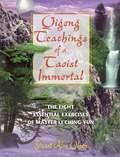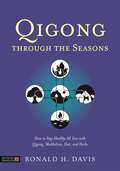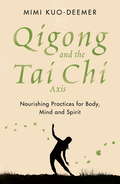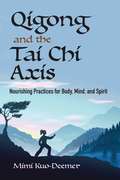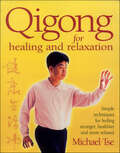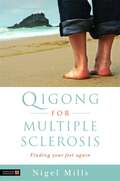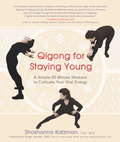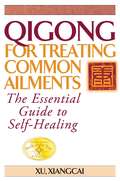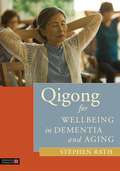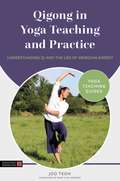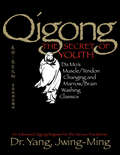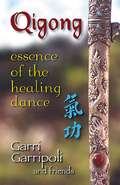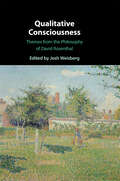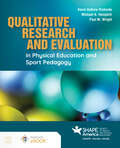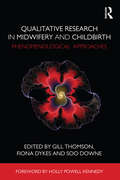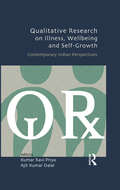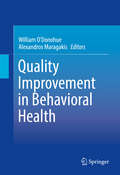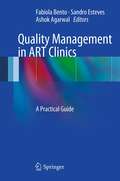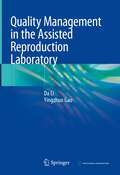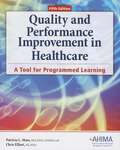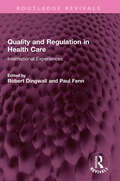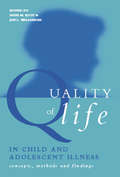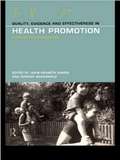- Table View
- List View
Qigong Teachings of a Taoist Immortal: The Eight Essential Exercises of Master Li Ching-yun
by Stuart Alve OlsonThe first English translation of Master Li Ching-yun's teachings on the Eight Brocades, the central practice of qigong.• Explains the physical and spiritual benefits of the Eight Brocades and offers step-by-step instructions for this powerful sequence of postures.• 85 illustrations highlight the postures and philosophies.• Author's commentary provides insight and depth to the original translation. Throughout history Taoists have promoted the development and restoration of the Three Treasures-- body, breath, and spirit--through the gentle practice of qigong. At the center of the qigong practice are the Eight Brocades, a series of postures that developed during the 3,000-year Taoist quest for longevity and vitality. Now qigong expert Stuart Olson translates into English Master Li Ching-yun's treasured teachings on the Eight Brocades. One of the most famous qigong masters of this century, Master Li Ching-yun is reliably chronicled to have lived more than 250 years, during which he practiced the Eight Brocades on a daily basis. His longevity and personal endorsements attest to and validate the Eight Brocades as the quintessence of Taoist health and qigong practices. With Master Li Ching-yun's original teachings as a guide, Stuart Olson presents an authentic yet accessible approach to this unique practice. Each exercise is accompanied by original text from Master Li, step-by-step instructions for each posture, illustrations of the positions, and insights on theory and practice. Because the Eight Brocades are the foundation of all qigong, this book provides valuable advice for all practitioners, regardless of the style they practice or the depth of their experience.
Qigong Through the Seasons: How to Stay Healthy All Year with Qigong, Meditation, Diet, and Herbs
by Ronald H. Davis Ken CohenWithin the holistic framework of the Daoist way, Ronald H. Davis provides a comprehensive and straightforward guide to the principles and practice of actively living in harmony with the seasonal energetic changes throughout the year. The program focuses on the importance of Qigong, meditation, and diet to support good mental and physical health. The author includes clear explanations of the theory underlying this approach to a healthy life, including the Five Phases of Change (Five Elements) of Chinese Medicine, the body's Qi system of channels and reservoirs, and the concept of chronobiology. For each season he provides a Qigong specific for the season, meditations, herbal information, and dietary recommendations with simple recipes to support the functions of the organ in focus in that season. This accessible program of Qigong for the seasons will be of interest to anyone seeking a healthy life, students of Qigong at any level, and the seasonal emphasis makes this an excellent quick reference for Qigong teachers.
Qigong and the Tai Chi Axis: Nourishing Practices for Body, Mind and Spirit
by Mimi Kuo-DeemerReduce stress, release pain and create whole body harmony with this practical introduction to Qigong and the yin/yang balance of Tai Chi, the ancient Chinese arts of 'movement meditation'. From reducing stress and improving posture to balance and general mobility, the many physical and mental benefits of Qigong and Tai Chi are widely celebrated. In this accessible book, Mimi Kuo-Deemer offers practices, insights and wisdom on these arts, and shows us how to support our natural capacity for energy, balance and wellbeing. Qigong's approach is based on the Chinese Five Elements or Phases of wood, fire, earth, metal and water. Each natural element relates to an organ and meridian system in the body, and Qigong and the Tai Chi Axis will explore each of these elements as they relate to our physical, mental and emotional health. It also will include popular and widely practiced sequences and forms such as the 8 Brocades, Five Animal Frolics, Tai Chi Qigong 18 Forms and Five Element Qigong practices and explore how these lead to wholeness, nourishment and health.Part I: Wood Element: Nourishing our Roots Part 2: Fire Element: Nourishing the Heart Part 3: Earth Element: Nourishing the Mind Part 4: Metal Element: Nourishing the SpiritPart 5: Water Element: Nourishing our Deepest Wisdom
Qigong and the Tai Chi Axis: Nourishing Practices for Body, Mind and Spirit
by Mimi Kuo-DeemerReduce stress, release pain and create whole body harmony with this practical introduction to Qigong and the yin/yang balance of Tai Chi, the ancient Chinese arts of 'movement meditation'. From reducing stress and improving posture to balance and general mobility, the many physical and mental benefits of Qigong and Tai Chi are widely celebrated. In this accessible book, Mimi Kuo-Deemer offers practices, insights and wisdom on these arts, and shows us how to support our natural capacity for energy, balance and wellbeing. Qigong's approach is based on the Chinese Five Elements or Phases of wood, fire, earth, metal and water. Each natural element relates to an organ and meridian system in the body, and Qigong and the Tai Chi Axis will explore each of these elements as they relate to our physical, mental and emotional health. It also will include popular and widely practiced sequences and forms such as the 8 Brocades, Five Animal Frolics, Tai Chi Qigong 18 Forms and Five Element Qigong practices and explore how these lead to wholeness, nourishment and health.Part I: Wood Element: Nourishing our Roots Part 2: Fire Element: Nourishing the Heart Part 3: Earth Element: Nourishing the Mind Part 4: Metal Element: Nourishing the SpiritPart 5: Water Element: Nourishing our Deepest Wisdom
Qigong and the Tai Chi Axis: Nourishing Practices for Body, Mind, and Spirit
by Mimi Kuo-Deemer"Mimi Kuo-Deemer takes the reader on a journey through the five elements and seasons of qigong, explaining their connection to health, lifestyle, and state of mind. . . . It is a pleasure to read such a balanced approach. I highly recommend Qigong and the Tai Chi Axis!" — Kenneth S. Cohen, author of The Way of QigongReduce stress, release pain, and create bodily harmony with this introduction to qigong and the yin/yang balance of tai chi, the ancient Chinese arts of movement meditation. This accessible book features information about these practices as well as insights into their benefits, providing tools for replenishing inner resources and managing energy levels. It also offers advice on making healthier choices in everyday life that will support the body's natural capacity for energy, balance, and well-being.
Qigong for Healing and Relaxation: Simple Techniques for Feeling Stronger, Healthier and More Relaxed
by Michael TseQigong (pronounced "chee-gong") is a popular form of traditional Chinese exercise that uses the body's vital energy to make you stronger and healthier and live longer.In Qigong for Healing and Relaxation,world-renowned Qigong Master Michael Tse introduces a new series of easy Qigong movements. These movements, because of their simplified form, enables you to focus energy on a particular part of the body for healing and relaxation. This fully illustrated guide to better health is suitable for people new to Qigong as well as more experienced students.
Qigong for Multiple Sclerosis: Finding Your Feet Again
by Nigel MillsThis book has been written to help people with Multiple Sclerosis (MS) improve their physical and psychological functioning using the Chinese system of movement and meditation known as Qigong, closely related to Tai Chi. Qigong focuses on the important basic principles of balance, body alignment and energy flow without the need to learn the complex patterns of Tai Chi. People with MS often experience impaired balance, difficulties in walking, tremor, low energy levels, and anxiety. Qigong can be used to improve their day-to-day wellbeing. The program described in this book was developed in a hospital setting and rigorously evaluated, and is cited by the National Institute of Clinical Excellence. Most of the participants reported specific improvements on many dimensions. The author provides a step-by-step guide, with photographs and clear text, to show how people with MS can improve their health and quality of life using Qigong. Many of the exercises can be done either seated or standing, and are suitable for anyone, regardless of their level of ability. He explains how to use Qigong to improve balance and walking, and promote healthy breathing and relaxation. He also explores the role of stress in triggering relapses in MS, and an approach designed to help people with MS overcome previous traumatic events, manage stress, and reduce the likelihood of further relapses is included. This practical book will help people with MS to find achievable ways to improve their lives. It will also be of great interest to carers, teachers of Tai Chi or Qigong, physiotherapists, occupational therapists, nurses and complementary therapists.
Qigong for Staying Young: A Simple 20-Minute Workout to Culitivate Your Vital Energy
by Shoshanna KatzmanGentle movements from the ancient Chinese art of self-healing and fitness to maintain youthful health and vitality. Shoshanna Katzman introduces readers to the practice of qigong through her graceful twenty-minute program that incorporates postures, breath, sound, visualization, and self-massage. This revitalizing workout will help women of all ages maintain youthful skin, eyes, and hair; improve fitness; and renew energy. Readers can then customize their routine, as the author explains how to apply the healing powers of qigong-along with herbal and dietary remedies-to specific age-related concerns such as arthritis, osteoporosis, menopause, weight gain, and decreased sexual vitality.
Qigong for Treating Common Ailments: The Essential Guide to Self-Healing
by Xiangcai XuForeWord's Book of the Year Award FINALIST - 2000Discover What China has Known for 1000 Years — Self-Healing Works! Wouldn’t it be nice to stop common ailments before they happen? We can prevent many of them once we have the proper knowledge. This book, Qigong for Treating Common Ailments, provides a system for maintaining overall health while addressing specific problems with exact treatments. All natural, safe, and easy to learn, these exercises provide a life-long path to wellness! This re-edited edition, originally published by a university press in China, is essential for the home health library! • Protect & Strengthen the Internal Organs with Qigong Exercises. • Improve Circulation and Overall Health using Qigong Massage Methods. • Discover a Wide Variety of Breathing and Relaxation Techniques. • Easy to Learn and Easy to Practice!
Qigong for Wellbeing in Dementia and Aging
by Laurha Frankfort The Natural Healing Research Foundation Stephen RathQigong is the centuries-old practice of moving vital energy (Qi) through the channels of the body, known as meridians, to promote vitality and health. Stephen Rath details current research and Traditional Chinese Medicine theory to show how Qigong practice can support cognitive functioning, as well as emotional and physical wellbeing, in people with dementia. Qigong for Wellbeing in Dementia and Aging presents a set of accessible Qigong exercises and breathing techniques adapted specifically for older people who may be frail or have limited mobility, which address specific symptoms associated with dementia. These include exercises for the hands and feet, exercises for releasing emotions through the Five Animal Sounds, seated exercises, and facial exercises. The exercises, contributed by the Natural Healing Research Foundation from their Senior Exercise Class in Hawaii, are presented with clear explanatory illustrations. The final part of the book describes the Chinese understanding of nutrition as an essential underpinning of good health into old age, and provides health-giving food and drink recipes for people with dementia based on these principles. There is also a helpful chapter on practicing Qigong to protect against caregiver burnout. This will be an invaluable book for care professionals, nurses, activity coordinators, and physical therapists, as well as people with dementia and their families.
Qigong in Yoga Teaching and Practice: Understanding Qi and the Use of Meridian Energy (Yoga Teaching Guides)
by Joo TeohThis book inspires yoga teachers to explore the synergy between qigong and yoga sequencing through an exploration of how qigong principles, postures and themes can be incorporated into yoga. It allows yoga teachers to add a dimension of physical and energetic awareness during movement and in asana. Introducing key concepts, Joo Teoh demonstrates the application of each aspect as well as addressing variations and adaptations for different physical limitations. This book is also supported by black and white illustrations and photographs.This book is part of the series 'Yoga Teaching Guides', which provides expert information on essential topics as well as ideas for creative teaching.
Qigong, The Secret of Youth: Da Mo's Muscle/Tendon Changing and Marrow/Brain Washing Classics (Qigong Ser.)
by Yang Jwing-MingForeWord's Book of the Year Award FINALIST - 2000For over one thousand years, Bodhidharma's (Da Mo) timeless classics have been considered the key to enlightenment and long-lasting youth. Now, Dr. Yang, Jwing-Ming, one of the world’s leading authorities on Qigong, has translated and written commentaries to make these ancient and profound teachings accessible to everyone. Using ancient Buddhist and Taoist documents as its foundation, this book analyzes and discusses theory and training methods in a modern, scientific manner, and presents safe ways for you to begin your own practice. Improve your health and strength through the Yi Jin Jing (Muscle/Tendon Changing Classic). Work towards longevity & enlightenment with the Xi Sui Jing (Marrow/Brain Washing Classic). Qigong, the Secret of Youth is an invaluable guide for Qigong practitioners and Martial Artists who want to explore deeper levels of internal energy training. • Learn the keys to rejuvenating & reconditioning your body. • Discover methods for nourishing the brain and bone marrow. • Includes Qigong exercises & massage techniques.
Qigong: Essence of the Healing Dance
by Garri GarripoliQigong (pronounced "chee-gong") is an ancient Chinese health-care modality that has fascinated people throughout the millennia. Based on the fundamental principles of traditional Chinese medicine, Qigong is a system that teaches us to understand Qi, our bioelectric life force, and use it to heal ourselves and others. Qigong: Essence of the Healing Dance will give readers some of the basics of the outward "exercises" that are normally associated with the practice of Qigong, as well as detailing movements from such systems as Wuji Qigong, Bagua Xun Dao Gong and Shaolin Qigong. More than merely outlining these practices, this book will take readers on a journey of exploration into the essence of this fascinating, though little understood, healing practice. Masters from around the world—such as the ninety-two-year-old Duan Zhi Liang of Beijing, Canadian healer Effie Poy Yew Chow and American Jerry Johnson—contribute their personal insights into the wonders of Qigong. People from various walks of life, all of whom have achieved healing as a result of practicing Qigong, share their powerful experiences. Author Garri Garripoli, himself a practitioner of Qigong for the past twenty years, renders the book fascinating yet easy-to-read. He expertly guides readers on this once-in-a-lifetime journey, inspiring them to look deeper into healing in order to discover how to move beyond the standards and limitations of Western medicine. Qigong: Essence of the Healing Dance shows readers that we all carry within ourselves the ability to heal, and encourages them to tap into that innate gift and dance their own dance of life. Readers are sure to find this book fascinating, even life changing. It is a must-read for anyone intrigued by the mystique of ancient Eastern healing arts or seeking a daily practice that promotes and maintains full-body well-being.
Qualia and Mental Causation in a Physical World
by Horgan, Terence and Sabatés, Marcelo and Sosa, David Terence Horgan Marcelo Sabatés David SosaHow does mind fit into nature? Philosophy has long been concerned with this question. No contemporary philosopher has done more to clarify it than Jaegwon Kim, a distinguished analytic philosopher specializing in metaphysics and philosophy of mind. With new contributions from an outstanding line-up of eminent scholars, this volume focuses on issues raised in Kim's work. The chapters cluster around two themes: first, exclusion, supervenience, and reduction, with attention to the causal exclusion argument for which Kim is widely celebrated; and second, phenomenal consciousness and qualia, with attention to the prospects for a functionalist account of the mental. This volume is sure to become a major focus of attention and research in the disciplines of metaphysics and philosophy of mind.
Qualitative Consciousness: Themes from the Philosophy of David Rosenthal
by Weisberg JoshQualitative consciousness is conscious experience marked by the presence of sensory qualities, like the experienced painfulness of having a piano dropped on your foot, or the consciousness of seeing the brilliant reds and oranges of a sunset. Over his career, philosopher David Rosenthal has defended an influential theoretical approach to explaining qualitative consciousness. This approach involves the development of two theories – the higher-order thought theory of mental state consciousness and the quality space theory of sensory quality. If the problem of explaining qualitative consciousness is divided into two more manageable pieces, the door opens to a satisfying explanation of what is seen by some to be an intractable explanatory puzzle. This interdisciplinary collection develops, criticizes, and expands upon themes inspired by Rosenthal's work. The result is an exciting collection of new essays by philosophers and scientists, which will be of interest to all those engaged in consciousness studies.
Qualitative Research and Evaluation in Physical Education and Sport Pedagogy
by Paul M Wright Kevin Andrew Richards Michael A HemphillPublished in conjunction with SHAPE America!Focusing on the unique nature of qualitative methods within kinesiology settings, Qualitative Research and Evaluation in Physical Education and Sport Pedagogy guides graduate students and early career researchers through designing, conducting, and reporting of qualitative research studies with specific references to the challenges and possibilities of the field.Written by qualitative researchers in the fields of physical education and activity, this practical text begins with an overview of qualitative methods before advancing into planning for, collecting, and analyzing qualitative data. The final sections highlight specific qualitative methods applications in physical education and activity before discussing future directions and emerging applications of qualitative research.Features and BenefitsA history of qualitative research is provided in Chapters 1 and 2, followed by several chapters that introduce a variety of contemporary qualitative research approaches.Experts in the field author each of the chapters, sharing their prior experience using the qualitative approachesExamples, tools, and insights throughout provide readers with helpful guidance in conducting qualitative research Critical thinking questions and activities at the end of each chapter provide resources for class discussion and promote reflection among readersNavigate eBook access (included with the printed text) includes the digital text enhanced with 6 author created videos, chapter review slides, and more. Research Methods in Physical & Health Education © 2024 | 450 pages
Qualitative Research in Midwifery and Childbirth: Phenomenological Approaches
by Soo Downe Gill Thomson Fiona DykesQualitative research, particularly phenomenology, is increasingly popular as a method for midwifery and health-related research. These approaches enable rich and detailed explanations to be uncovered and bring experience to life. Important recommendations and practice- based implications may then be raised and debated for future use. This book brings together a range of phenomenological methods and insights into one accessible text. Illustrated with plenty of examples of successful phenomenological research, Qualitative Research in Midwifery and Childbirth keeps the focus applied to midwifery and childbirth and makes clear the links to practice throughout. The book introduces three key phenomenological approaches – descriptive, interpretive and the life world – and includes a comparative chapter which discusses the differences between these varied perspectives and methods. Each chapter focuses on how these approaches are used within midwifery research. The remaining chapters present a number of different research projects. These demonstrate how different phenomenological approaches have been used to explore and uncover experiences of childbirth and maternity as well as offering important insights into how women experience different facets of the birth experience during the antenatal, intra-partum and postnatal period. Designed for researchers and students undertaking research projects on midwifery and childbirth, this text includes contributions from a range of international and highly regarded phenomenological authors and researchers.
Qualitative Research on Illness, Wellbeing and Self-Growth: Contemporary Indian Perspectives
by Kumar Ravi Priya Ajit Kumar DalalThis book examines the theoretical, methodological and practical dimensions of Qualitative Research in the study of illness, wellbeing and self-growth in the Indian context. Using wide-ranging narratives, interviews, group discussions, and cultural analyses, it offers a social and psychological understanding of health and therapy.
Quality Improvement in Behavioral Health
by William O'Donohue Alexandros MaragakisThis innovative volume presents a cogent case for quality improvement(QI) in behavioral healthcare as ethical practice, solid science, and goodbusiness. Divided between foundational concepts, key QI tools and methods, andemerging applications, it offers guidelines for raising care standards whileaddressing ongoing issues of treatment validity, staffing and training, costsand funding, and integration with medical systems. Expert contributors reviewthe implications and potential of QI in diverse areas such as treatment ofentrenched mental disorders, in correctional facilities, and within theprofessional context of the American Psychological Association. The insights,examples, and strategies featured will increase in value as behavioral healthbecomes more prominent in integrated care and vital to large-scale health goals. Included in the coverage: Behavioral health conditions: direct treatment costs and indirect social costs. Quality improvement and clinical psychological science. · Processmapping to improve quality in behavioral health service delivery. · Checklists for quality improvement and evaluation in behavioralhealth. · Creating a quality improvement system for an integrated careprogram: the why, what, and how to measure. · Feedback Informed Treatment (FIT): improving the outcome ofpsychotherapy one person at a time. Quality Improvement i n Behavioral Healthcare gives healthpsychologists, public health professionals, and health administrators areal-world framework for maintaining quality services in a rapidly evolvinghealth landscape.
Quality Management in ART Clinics
by Ashok Agarwal Fabiola Bento Sandro EstevesIn the last decades, major advances have been made in assisted reproductive technologies (ART) and the public demand for these procedures has increased globally. All ART clinics, from those just starting out to the well established, must employ the latest equipment and implement the best practices, while ensuring that their resources are effectively engaged to optimize patient outcomes. This is a tenet of the fiduciary role of physicians and it is increasingly recognized as a quantifiable goal regulated by formal certifications and accreditations. Quality management protocols such as those proposed by the International Organization for Standardization (ISO) are being rapidly adopted as standards of measure. Quality Management in ART Clinics: A Practical Guide provides easily adoptable ways to implement and improve formalized quality management systems. Essential to any clinic to achieve best practices and maintenance of formal regulatory certifications, this book brings together the know-how of experienced opinion leaders operating in key areas worldwide. The book offers an overview of primary regulations in the ART field, with attention to quality management demands, and links specific requirements to practical steps for implementation. Filled with process and procedure examples, flow diagrams and administrative form templates, this book is the first of its kind, gathering the necessary elements for optimizing practice, management, and quality assurance.
Quality Management in the Assisted Reproduction Laboratory
by Da Li Yingzhuo GaoThis book provides readers up-to-date information on various aspects affecting assisted reproduction laboratories and corresponding management approaches, based on latest literatures, clinical practice, and international consensus. Key points of laboratory environment, laboratory operations and quality control measures are presented in details. Last but not least, ethical issues and countermeasures of assisted reproductive technology are discussed. It will be a practical and reader-friendly resource to help reproductive medicine practitioners establish a disciplined risk and control system for assisted reproduction laboratories and techniques.
Quality and Performance Improvement in Healthcare: A Tool for Programmed Learning
by Chris Elliott Patricia L. ShawThis is the fifth edition of the best-selling Quality and Performance Improvement in Healthcare: A tool for Programmed Learning. Covering trends in healthcare quality control and performance, it also serves as a solid source on Performance Improvement (PI) foundations, fundamentals, and core principles.
Quality and Regulation in Health Care: International Experiences (Routledge Revivals)
by Robert Dingwall Paul FennFirst published in 1992, Quality and Regulation in Health Care employs socio-legal ideas concerning regulation to examine the methods used to influence the quality of health care in the US, UK, and Western Europe. Throughout the Western world, health care systems, both public and private, are grappling with the problems of assuring quality while containing costs. On the one hand, governments and insurers argue that there must be some limit to the apparently endless growth of health care expenditures. On the other, patient groups and consumer advocates, already dissatisfied by the problems in holding doctors accountable for their actions, protest that such limits must not result in sick people getting inferior treatment. This book examines in detail the debate surrounding the question: How can the professional expertise of the clinicians be reconciled with the preferences of their patients and the economic concerns of taxpayers or insurers? It will be essential reading for graduate and undergraduate courses in health policy, medical sociology, and health law.
Quality of Life in Child and Adolescent Illness: Concepts, Methods and Findings
by Hans M. Koot Jan L. WallanderHow can we measure the quality of life in children and adolescents with chronic disease? Major progress in the diagnosis and treatment of severe and chronic disease has led to an increased number of children and their families having to adapt and cope with the impact of disease, survival, and the cost of treatment. Health professionals have responded to this by developing a diversity of instruments for measuring quality of life for use in paediatrics, psychology and public health. This book introduces the reader to the emerging field of quality of life assessment and provides a comprehensive overview of the conceptual and methodological issues concerning quality of life in child and adolescent illness. Particular emphasis is provided on current efforts to measure the impact of specific chronic conditions on different domains of child functioning. Future directions are outlined for the development of appropriate instruments for measuring quality of life in children and adolescents. Quality of Life in Child and Adolescent Illness is intended for psychologists, paediatricians, paediatric nurses, child psychiatrists, public health professionals, researchers and other interested readers from the undergraduate to the working professional.
Quality, Evidence and Effectiveness in Health Promotion: Striving For Certainties
by Gordon Macdonald John Kenneth DaviesQuality, Evidence and Effectiveness is unique in bringing together, for the first time, the critical concepts of quality assurance and effectiveness in relation to health promotion and research.Contributions from leading health promotion specialists around the world discuss how best to push forward evidence of the value of health promotion as an effective investment strategy. They examine particular examples of health promotion interventions, focusing on both practical suggestions and the concepts underlying them.Contributions are divided into three core sections:* the examination of effectiveness studies through the application of different evaluation methodologies * practice-based quality assurance programmes * the examination of examples of health promotion interventionsQuality, Evidence and Effectiveness will be invaluable to students, researchers and policy-makers in health promotion and all professionals who are committed to the effective and efficient delivery of New Public Health.
